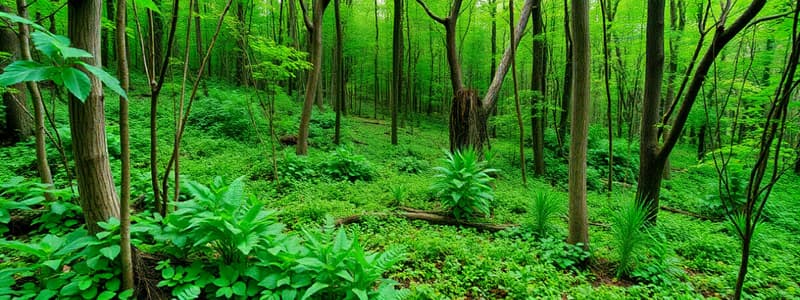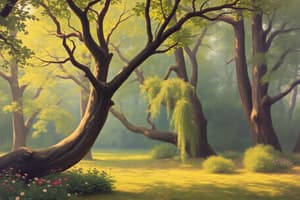Podcast
Questions and Answers
What is the definition of 'Biodiversity'?
What is the definition of 'Biodiversity'?
The variety of living organisms
What is the definition of 'Carrion'?
What is the definition of 'Carrion'?
decaying flesh and tissue of dead animals
What is the definition of 'Community'?
What is the definition of 'Community'?
made up of the populations of different species living in a habitat.
What is the definition of 'Competition'?
What is the definition of 'Competition'?
What is the definition of 'Consumers'?
What is the definition of 'Consumers'?
What is the definition of 'Decomposers'?
What is the definition of 'Decomposers'?
What is the definition of 'Deforestation'?
What is the definition of 'Deforestation'?
What is the definition of 'Ecosystem'?
What is the definition of 'Ecosystem'?
What is the definition of 'Global warming'?
What is the definition of 'Global warming'?
What is the definition of 'Habitat'?
What is the definition of 'Habitat'?
What is the definition of 'Interdependence'?
What is the definition of 'Interdependence'?
What is the definition of 'Predators'?
What is the definition of 'Predators'?
What is the definition of 'Prey'?
What is the definition of 'Prey'?
What is the definition of 'Scavengers'?
What is the definition of 'Scavengers'?
What are Abiotic factors?
What are Abiotic factors?
What are Adaptations?
What are Adaptations?
What is a Food chain?
What is a Food chain?
What are Structural adaptations?
What are Structural adaptations?
What are Behavioural adaptations?
What are Behavioural adaptations?
What are Functional adaptations?
What are Functional adaptations?
What is Competition?
What is Competition?
What is Mutualism?
What is Mutualism?
What is Parasitism?
What is Parasitism?
What is Deforsestations and Land Use?
What is Deforsestations and Land Use?
How are Peat bogs produced?
How are Peat bogs produced?
What is the effect of burning Peat?
What is the effect of burning Peat?
Flashcards
Biodiversity
Biodiversity
The variety of living organisms in a particular area.
Carrion
Carrion
Decaying flesh of dead animals.
Community
Community
All the populations of different species in a habitat.
Competition
Competition
Signup and view all the flashcards
Consumers
Consumers
Signup and view all the flashcards
Decomposers
Decomposers
Signup and view all the flashcards
Deforestation
Deforestation
Signup and view all the flashcards
Ecosystem
Ecosystem
Signup and view all the flashcards
Global warming
Global warming
Signup and view all the flashcards
Habitat
Habitat
Signup and view all the flashcards
Interdependence
Interdependence
Signup and view all the flashcards
Population
Population
Signup and view all the flashcards
Predators
Predators
Signup and view all the flashcards
Prey
Prey
Signup and view all the flashcards
Producers
Producers
Signup and view all the flashcards
Scavengers
Scavengers
Signup and view all the flashcards
Species
Species
Signup and view all the flashcards
Abiotic factors
Abiotic factors
Signup and view all the flashcards
Biotic factors
Biotic factors
Signup and view all the flashcards
Structural adaptations
Structural adaptations
Signup and view all the flashcards
Behavioral adaptations
Behavioral adaptations
Signup and view all the flashcards
Functional adaptations
Functional adaptations
Signup and view all the flashcards
Food Chain
Food Chain
Signup and view all the flashcards
Mutualism
Mutualism
Signup and view all the flashcards
Parasitism
Parasitism
Signup and view all the flashcards
Study Notes
Keywords
- Biodiversity - the variety of living organisms
- Carrion - decaying flesh and tissue of dead animals
- Community - made up of different species living in a habitat
- Competition - the negative interaction between two or more organisms needing the same resource
- Consumers - feed on other organisms for energy (primary, secondary, or tertiary)
- Decomposers - organisms that feed on dead organisms, breaking down biomass and releasing nutrients
- Deforestation - removal and destruction of trees in a forest or woodland
- Ecosystem - the interaction between living organisms and their environment
- Global warming - the increase in average global temperature
- Habitat - where a living organism lives
- Interdependence - the interaction between organisms, where it is mutually beneficial
- Population - the number of individual organisms of a species in a habitat
- Predators - organisms that kill for food
- Prey - animals eaten by predators
- Producers - organisms that convert the sun's energy into useful compounds through photosynthesis (plants or algae)
- Scavengers - organisms that feed on dead animals (carrion)
- Species - organisms of similar morphology that can interbreed to produce fertile offspring
Abiotic and Biotic Factors
- Abiotic factors - non-living factors in an environment (moisture, light, temperature, CO₂, wind, O₂ or pH)
- Biotic factors - living factors in an environment (predators, competition, pathogens, availability of food)
- Adaptations - specific features of an organism enabling survival in its habitat (structural, behavioural, functional)
- Structural adaptations - physical features (e.g., colour for camouflage)
- Behavioural adaptations - how an organism behaves (e.g., migration)
- Functional adaptations - how physiological processes work (e.g., lower metabolism during hibernation)
- Adaptations are not developed during a single lifetime, but rather are variations within a species, with advantageous features being passed on to offspring via natural selection.
Food Chains
- The sun is the source of all energy in a food chain
- Plants and algae use sunlight for photosynthesis producing organic compounds
- Living organisms use energy to produce biomass and grow
- When a living thing is eaten, some energy is transferred, but some is lost.
- Arrows in food chains indicate energy flow.
- Predator and prey populations fluctuate cyclically.
- Overall, a stable community demonstrates a balanced ecosystem.
Competition
- Species compete with one another for survival and reproduction
- Plants compete for resources like light, water, space, and minerals to help photosynthesis.
- Animals compete for food, water, space, and mates
- Intraspecific competition is competition within a species.
- Interspecific competition is competition between different species.
Mutualism, Parasitism, and other Interactions
- Mutualism - both species benefit from a relationship
- Parasitism - one species benefits, but the other is harmed.
- Competition - both species are harmed as they both need the same limited resources
- Animals compete for resources like food, water, and space/shelter.
Deforestation and Land Use
- Humans use land for buildings, quarrying, mining, agriculture, and landfill
- Deforestation destroys habitats
- Peat bogs store carbon and release it during destruction.
- Burning peat and trees release carbon dioxide, contributing to the greenhouse effect
- Reduced tree cover lessens carbon dioxide removal through photosynthesis.
- Global warming can lead to changes to the ecosystem and reduce biodiversity.
Studying That Suits You
Use AI to generate personalized quizzes and flashcards to suit your learning preferences.


